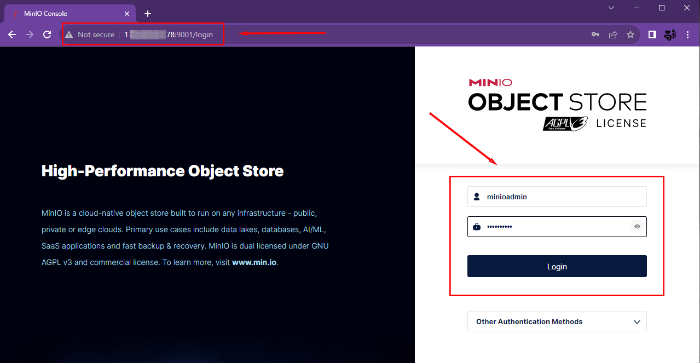MinIO¶
Bu makalede
Bilgi
MinIO, Amazon S3 API ile uyumlu açık kaynaklı bir nesne depolama sistemidir. Fotoğraflar, videolar, günlükler, yedeklemeler vb. gibi yapılandırılmamış verileri depolamayı sağlar.
MinIO: Ana Özellikler¶
- Ölçeklenebilir nesne deposu: MinIO, herhangi bir büyüklükte sınırsız sayıda nesneyi depolamaya olanak sağlar. Depolama hacmi yeni sunucular ekleyerek kolayca ölçeklendirilebilir.
- S3 uyumlu API: MinIO, nesneleri saklamak ve almak için Amazon S3 REST API'nı uygulamaktadır, bu da mevcut S3 kütüphanelerini ve araçlarını kullanmayı mümkün kılar.
- Yüksek erişilebilirlik: Veriler birden fazla küme düğümüne çoğaltılır. Bir düğüm başarısız olursa veri erişimi devam eder.
- Veri şifreleme: Nesneler, simetrik anahtar kullanılarak istemcinin tarafında şifrelenir. SSE-C, SSE-S3 ve SSE-KMS desteklenir.
- Çoklu kullanıcı erişimi: Farklı kullanıcılar için erişimi sınırlamak amacıyla ACL ve IAM politikaları desteği.
- Nesne versiyonlaması: Nesnelerin birden fazla sürümünü depolama ve bunları geri yükleme yeteneği.
- Veri çoğaltılması: Coğrafi dağılım için farklı bölgelere verilerin senkronlu çoğaltılması.
- Sunucu düzeyinde önbelleğe alma: Sıkça talep edilen nesnelerin küme düğümlerinde ön belleğe alınması.
- Ölçeklenebilirlik: Performans ve depolama kapasitesi yatay ölçeklenebilirliği.
- Web arayüzü: Depolama yönetimi ve izleme için yerleşik GUI.
- Güvenirlilik: Yerleşik arıza kurtarma, kendini iyileştiren mimari.
Çalıştırma Özellikleri¶
| ID | Uyumlu OS | VM | BM | VGPU | GPU | Min CPU (Çekirdekler) | Min RAM (GB) | Min HDD/SSD (GB) | Aktif |
|---|---|---|---|---|---|---|---|---|---|
| 43 | Ubuntu 22.04 | + | + | + | + | 1 | 1 | - | Evet |
- Bağlantılı dizinlere yönlendirme:
/data;
MinIO'yu dağıtıldıktan sonra başlangıç¶
Siparişiniz ödendikten sonra, kayıt sırasında sağladığınız e-posta adresine bir e-posta bildirimi gönderilecektir. Bu bildirim, sunucunuzu kullanmaya hazır olduğunu size bildirecektir. Bildirime VPS'nizin IP adresi, bağlantı için giriş bilgileriniz ve şifreniz de dahil olacaktır.
Şirket müşterilerimiz ekipmanlarını sunucu yönetim paneli ve API — Invapi aracılığıyla yönetmektedir.
- MinIO web arayüzüne erişim bağlantısı: webpanel etiketinde;
- Giriş:
minioadmin; - Şifre:
minioadmin.

Panelde başarılı bir şekilde oturum açtıktan sonra, Access Keys >> Change Password sekmesinde yeni kimlik bilgileri ayarlayın:

-
Hizmet Yönetimi:
1.1. Hizmet Durumunu Kontrol Et
1.2. Hizmeti Yeniden Başlat
1.3. Hizmeti Durdur
-
Konfigürasyon:
- Ana Konfigürasyon Dosyası:
/etc/default/minio - Veri Dizini:
/mnt/data - Systemd Hizmet Dosyası:
/etc/systemd/system/minio.service
- Ana Konfigürasyon Dosyası:
Not
MinIO'nun temel ayarları hakkında daha fazla bilgi için geliştiricilerin belgelerini inceleyebilirsiniz.
API kullanarak MinIO ile sunucu sipariş etme¶
Bu yazılımı API kullanarak kurmak için bu talimatları izleyin.